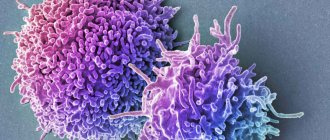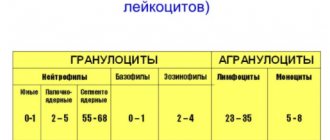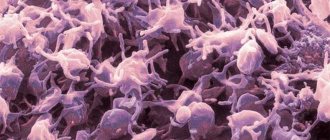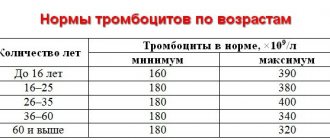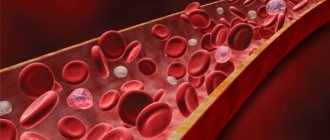Content:
- Neutrophils and their functions
- Detailed blood test
- The norm of neutrophils in a child’s blood
- Increase in neutrophils in the blood of a child
- Decrease in neutrophils in the blood of a child
- Deviations not related to disease
← The level of basophils has decreased in adults: how to treat basophilia
Functions and possible causes of pathologies of segmented neutrophils →
A mandatory procedure during a medical examination for both adults and children is a blood test. This is due to the fact that a specialist in indicators can determine the condition of the body, as well as detect the presence of diseases.
An important parameter is the number of neutrophils in the blood. Any deviation from the norm in a child is an alarming sign. Let’s take a closer look at what these cells are, what their functions are, and also why a child’s neutrophils may be low or high.
The number of neutrophils changes during a child's illness. It can be either low or high
How to determine the level
Neutrophils in a child can be examined in the following ways:
- clinical blood test;
- blood chemistry;
- bone marrow biopsy.
General blood analysis
The quantitative composition of neutrophils can be determined using a complete blood count (CBC), because these white blood cells quickly respond to changes in the body.
In order for the research result to be accurate, the following rules must be followed:
- take the test on an empty stomach;
- for several days before taking the OAC, do not eat spicy and fried foods, as well as foods with preservatives and food additives;
- if possible, do not take medications;
- avoid intense muscle activity;
- ensure a stable emotional state;
- avoid sudden changes in temperature.
During the OAC test, there should be no wounds, scratches, cuts or other damage to the skin. If the child has been vaccinated, then the OAC can be taken after 1-4 weeks.
Blood chemistry
If neutrophils in the blood of children differ greatly from the norm in the direction of increase (neutrophilia, shift of the leukocyte formula to the left), and such a deviation persists for a long time, then additional research should be carried out. A biochemical blood test (BAC) allows you to clarify and expand the information.
Important information: How many leukocytes should there be in the blood for cancer?
Blood is drawn from a vein. The rules for preparing for the test are the same as for the OAC.
Bone marrow biopsy
The study is carried out if a strong and stable deviation from acceptable indicators is detected. The indication for analysis is a condition in which the norm of young cells is exceeded by 5% against the background of the absence of a history of the following factors:
- intoxication;
- chronic infectious disease;
- irradiation;
- blood loss;
- chronic stress;
- taking specific medications.
If the norm of neutrophils in children is exceeded by more than 10%, this may indicate the development of blood cancer. At concentrations below normal levels, chromosomal disturbances in the synthesis of blood cells are possible.
The biopsy is performed in an outpatient clinic or hospital using local anesthesia.
If the baby is 1 year or younger, then the biomaterial is taken from the femur, tibia or calcaneus. In older children - from the pelvic bone.
Neutrophils and their functions
Neutrophils are blood cells that are a type of white blood cell. They are formed in the bone marrow. The blood contains about one percent of these cells, and the rest are distributed in the organs of the human body and the place of their origin.
Neutrophils are of two types according to the degree of maturity:
- Rods. These cells are immature and do not have a full nucleus. Band neutrophils are present in large numbers in infants;
- Segmented. They are mature cells and have a clearly formed nucleus.
Functions of neutrophils:
- taking the blow as the body’s protectors from microbes, as well as various viruses, fungi and bacteria in the child’s body;
- absorption of foreign elements, as well as old and dead cells in order to restore the child’s body.
Blood composition. Neutrophils are a group of leukocytes or white blood particles
We also recommend studying this topic:
What to do if the level of basophils increases and what could this mean?
The role of neutrophils in the children's body
The production of neutrophils occurs in the red bone marrow, an important organ of hematopoiesis and immunopoiesis. After leaving it, the cells move for several hours as part of the peripheral blood. They then migrate into the tissue and can remain there for some time.
A characteristic feature of newly formed cells is the presence of granularity (granules) in their internal environment. Neutrophil granules contain antibacterial agents, thanks to which the cells are able to perform the following functions:
- protect the baby’s body from infections. Neutrophils are the first to encounter microbes, bacteria, viruses and take the blow, trying to quickly destroy the uninvited guests;
- capture and absorb solid foreign particles, dead cells, neutralize and remove them out. Neutrophils are classical phagocytes. And here the decisive role is played by the fact that they are very mobile and are able to penetrate without any obstacles into the most remote corners of the baby’s body. The cells do not move chaotically, but towards the site of tissue damage or the inflammatory process.
Cells circulate in the blood in two varieties:
- Banded (not yet mature).
- Segmented (reached maturity).
Detailed blood test
A doctor may prescribe this type of test for a child if there is a suspicion of a disease or as a routine check. Most often, additional research is carried out in the presence of infections of both viral and bacterial origin, as well as when anemia is detected in a child or in cases where poisoning has been suffered.
Video with Dr. Komarovsky: How to determine a viral or bacterial infection in a child using a blood test?
A study on the number of neutrophils is carried out by collecting capillary blood from a finger in the morning. There are few preparation requirements. Before the procedure, you should not feed your child or allow him to rub his fingers before taking blood: the results may be distorted.
The norm of neutrophils in a child’s blood
This is what the blood test data looks like. In this case, the child is 1 month old and has 13% segmented neutrophils, which is slightly below the norm, and 2% band neutrophils - this is the norm
The normal number of neutrophils in a child depends on his age. These indicators are a part of the leukocyte formula, and if they are within the required limits, then this indicates that the immune system is in perfect order and functioning at the proper level.
The norm of segmented neutrophils from the total number of leukocytes in%:
- in infants from 0 to 1 month - 45-80%;
- norm up to a year from 1 month - 15-45%;
- from 1 year to 13 years - 35-62%.
The norm of band neutrophils from the total number of leukocytes in%:
- in infants from 0 to 1 month - 3-17%;
- from 1 month to a year - 0.5 to 4%;
- from 1 year to 13 years - from 0.7 to 5%.
Important! It is necessary to monitor the composition of the blood on an ongoing basis, since any deviation is an alarming sign, and as you know, the faster the disease is detected, the easier it is to cure it.
We also recommend studying this topic:
Lymphocytes in a child are increased or decreased: causes and consequences of deviations
What it is?
So, what are band neutrophils, and most importantly, how do they differ from other representatives of granulocytes? Band neutrophils are immature segmented cells from the leukocyte family. The latter, as you know, are familiar defenders of the body, serving as the basis of immunity. At first, rod-nucleated neutrophils appear in the body, whose nuclei are similar to rods that have not yet had time to divide into segments. These cells mature directly in the body's blood.
Such cells are born within the human bone marrow, then they are released into the blood. These elements are not able to penetrate the tissue or dissolve pathogenic bacteria in themselves. They are in the blood, maturing there. The normal level of neutrophils in the blood may differ depending on the age of the patients. For men and women, the rate of band neutrophils is the same. Neutrophils in the analysis are important for absolutely all specialists. You should know that only a mature neutrophil is able to penetrate the vascular walls and neutralize all kinds of foreign cells inside the tissue.
Increase in neutrophils in the blood of a child
An increased number of neutrophils in the blood of a child may be a sign of the presence of a disease
If a child’s neutrophils are very elevated at the age of more than 1 year, then this is considered an alarming sign. With a slight increase in their level, there is no reason for concern, as this may be associated with physical stress or nervousness and stress.
If band or segmented neutrophils in a child are increased by more than 6.5 billion per liter of blood, then this indicates the presence of neutrophilia. This situation occurs if there are:
- purulent abscesses;
- hemolytic anemia;
- 3rd or 4th degree skin burns;
- leukemia or trophic ulcers;
- inflammatory diseases. Among them: sore throat and sepsis, as well as pneumonia and others.
The intensity of the inflammatory process is determined by the number of neutrophils. The more there are, the larger the outbreak. If a child's neutrophils are elevated, further testing is necessary to determine the cause of the increased number of these cells.
An increase in neutrophils in the blood is dangerous because it is an indicator of the presence of acute foci of inflammation in the child’s body. A shift in the leukocyte formula may indicate the presence of infectious diseases, both open and latent. The worst thing is that an increase in neutrophils can indicate the presence of tumors, both benign and malignant.
Deviations
The segments in children's blood may change as they grow older. Their absolute and relative values make it possible to assess the state of health.
Increasing values
A temporary and slight increase in the level of neutrophil granulocytes is allowed against the background of physical activity and negative emotions, while the concentration of other blood cells should not be subject to changes. If a prolonged increase in the level of neutrophils and leukocytes (neutrophilia) is detected, the child must be further examined.
Neutrophilia can occur when:
- leukemia;
- hemolytic anemia;
- acute inflammatory diseases;
- tissue necrosis due to burns, tropical ulcers;
- diabetes mellitus
If only segmented neutrophils increase, then the following may develop:
- acute inflammatory process;
- infections without specific symptoms;
- benign or malignant tumor.
If there is a sharp and significant jump in the level of neutrophils, the child must be urgently examined and treated.
Downgrade
When the functions of the immune system are weakened, the concentration of neutrophils decreases (neutropenia). In a child's body, cells work hard and are destroyed, divided in insufficient quantities or distributed incorrectly.
Important information: What do low neutrophils in the blood of an adult indicate (reasons and how to increase)
Causes of neutropenia;
- dysfunction of the bone marrow;
- recent illness;
- viral diseases (rubella, ARVI, measles);
- anemia;
- thyrotoxicosis (thyroid dysfunction);
- fungal diseases;
- exposure to chemicals;
- taking painkillers.
In the first year of life, children may develop chronic benign neutropenia. It is not uncommon for this condition to last for several years. In this case, the child does not have any health problems, and the characteristic clinical picture does not appear. The disease does not require treatment and goes away on its own.
Decrease in neutrophils in the blood of a child
A reduced number of neutrophils or their complete absence causes a decrease in the child’s immunity. Need specialist help
If segmented neutrophils are low in a child, this indicates a decrease in immunity. When the level of neutrophils is less than 1.6 billion per liter, the condition is called neutropenia. This situation may arise if there is a malfunction of the bone marrow or if the child has suffered a serious illness. In this case, neutrophils die and do not have time to recover.
There are several reasons why neutrophils may be low. Among them:
- viral diseases: rubella, influenza and others;
- infections of fungal origin;
- anaphylactic shock;
- intoxication with substances of chemical origin;
- different types of anemia;
- radiation exposure.
The reasons for the decrease in segmented neutrophils are described in more detail in the following article on our website.
Band neutrophils are immature cells that do not have a nucleus and do not fully perform their functions.
How are such rods in the blood designated?
Typically, the number of neutrophil cells is expressed as a percentage of the total number of leukocytes. The analysis of band neutrophils in the blood allows doctors to make an accurate diagnosis and find out how the bone marrow performs its functions.
This study is called a comprehensive clinical blood test.
Deviations not related to disease
Situations in which deviations from the norm in indicators are not caused by diseases are different. Among the main ones:
- Heredity. There may be a situation when the child is completely healthy, but a blood test shows that there are few neutrophils, and when the test is repeated, their level remains the same. Then this is not a violation;
- Low neutrophils are not uncommon when painkillers are taken for seizures, but high neutrophils are common when drugs such as corticosteroids are used.
Important! In the above situations, an extended blood test will not provide information about the presence or absence of a disease in the child, but will provide a hint for a more accurate diagnosis, which will ensure timely detection and treatment.
When donating blood for neutrophils, if the norm is revealed, then this only means that the child is completely healthy.
Segmented neutrophils are mature cells that are capable of performing functions to protect the child’s body. They have a core
Neutrophils are important for the child’s body, as they are the main fighters against bacteria and infections. A decrease or increase in their number is evidence of the presence of a disease or inflammatory process. In such a situation, you should immediately consult a doctor to conduct a detailed examination and prescribe treatment for the disease that caused the shift in the leukocyte formula.
← The level of basophils has decreased in adults: how to treat basophilia
Functions and possible causes of pathologies of segmented neutrophils →
We recommend studying similar materials:
- 1. Hemostasis system: why take a blood clotting test
- 2. Autoimmune hemolytic anemia in children: what is missing and how it manifests itself
- 3. How to choose a diet based on your blood type: losing weight together
- 4. Causes and dangers of increased basophil levels in children
- 5. The level of basophils in adults has decreased: how to treat basophilia
- 6. Functions and possible causes of pathologies of segmented neutrophils
- 7. What does a high level of neutrophils mean and is it dangerous?
The norm for this indicator during pregnancy
The norm for band neutrophils in women is practically no different from the norm for a pregnant woman. It should be noted that during the gestation period, doctors consider a slight excess of standard indicators to be natural.
Increased levels can be observed in pregnant women mainly after a heavy lunch, and also during work or against a background of stress. So, the norm of band neutrophils during pregnancy is:
- From 40 to 77% segmented neutrophils.
- From 1 to 6% of band immature neutrophils.
